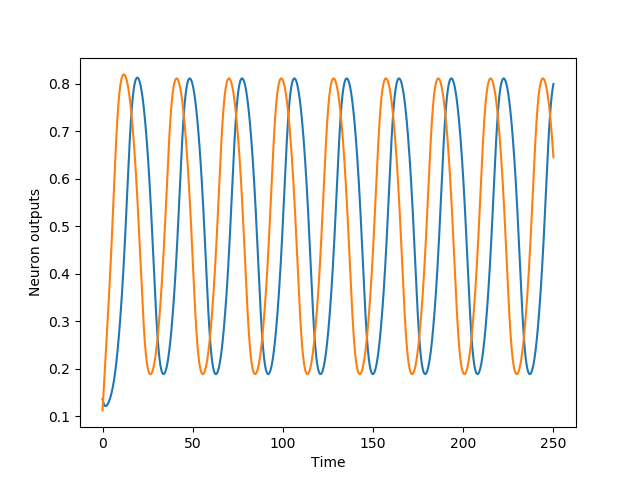Python package that implements Continuous Time Recurrent Neural Networks (CTRNNs)
See Beer, R.D. (1995). On the dynamics of small continuous-time recurrent neural networks. Adaptive Behavior 3:469-509. for a study of CTRNNs.
Using this repo in conjunction with StochSearch allows you to optimize CTRNNs to perform different tasks. Stochsearch uses Python's multiprocessing framework to parallelize population based stochastic search optimization methods.
You can also find a Tensorflow version of building and implementing a population of CTRNNs here. Refer to this same repo for optimizing CTRNNs using Tensorflow on a GPU.
$ pip install CTRNN
Requirements: numpy, scipy
@misc{Candadai_CTRNN_2020,
author = {Candadai, Madhavun},
month = {3},
title = {CTRNN},
url = {https://github.com/madvn/CTRNN},
year = {2020}
}
from CTRNN import CTRNN
cns = CTRNN(network_size,step_size=0.1)
weights are initialized randomly; gains, time-constants and biases are set to 1
cns.gains[i] = 1
where i is in range [0,network_size)
cns.gains = [1,2,3,..]
with list of size=network_size
cns.biases
cns.taus
cns.weights[i,j] = 3
where i,j in range [0,network_size)
from scipy.sparse import csr_matrix
cns.weights = csr_matrix(weights_matrix)
where weights_matrix is of size=network_sizeXnetwork_size
cns.euler_step(external_inputs)
where external_inputs is a list of size=network_size
print(cns.outputs[i])
cns.outputs[i] = 0.5
where i in range [0,network_size) and output in range [0,1]
print(cns.outputs)
cns.outputs = [0.5,0.75,0.4]
where list is of size=network_size
cns.states
where state values can range in (-inf,inf)
cns.randomize_states(ub,lb)
upper bound and lower bound in range (-inf,inf)
cns.randomize_outputs(ub,lb)
upper bound and lower bound in [0,1]
The following code creates a 2-neuron CTRNN sinusoidal oscillator, See demo folder::
# imports
import numpy as np
import matplotlib.pyplot as plt
# importing the CTRNN class
from CTRNN import CTRNN
# params
run_duration = 250
net_size = 2
step_size = 0.01
# set up network
network = CTRNN(size=net_size,step_size=step_size)
network.taus = [1.,1.]
network.biases = [-2.75,-1.75]
network.weights[0,0] = 4.5
network.weights[0,1] = 1
network.weights[1,0] = -1
network.weights[1,1] = 4.5
# initialize network
network.randomize_outputs(0.1,0.2)
# simulate network
outputs = []
for _ in range(int(run_duration/step_size)):
network.euler_step([0]*net_size) # zero external_inputs
outputs.append([network.outputs[i] for i in range(net_size)])
outputs = np.asarray(outputs)
# plot oscillator output
plt.plot(np.arange(0,run_duration,step_size),outputs[:,0])
plt.plot(np.arange(0,run_duration,step_size),outputs[:,1])
plt.xlabel('Time')
plt.ylabel('Neuron outputs')
plt.show()
Output:
